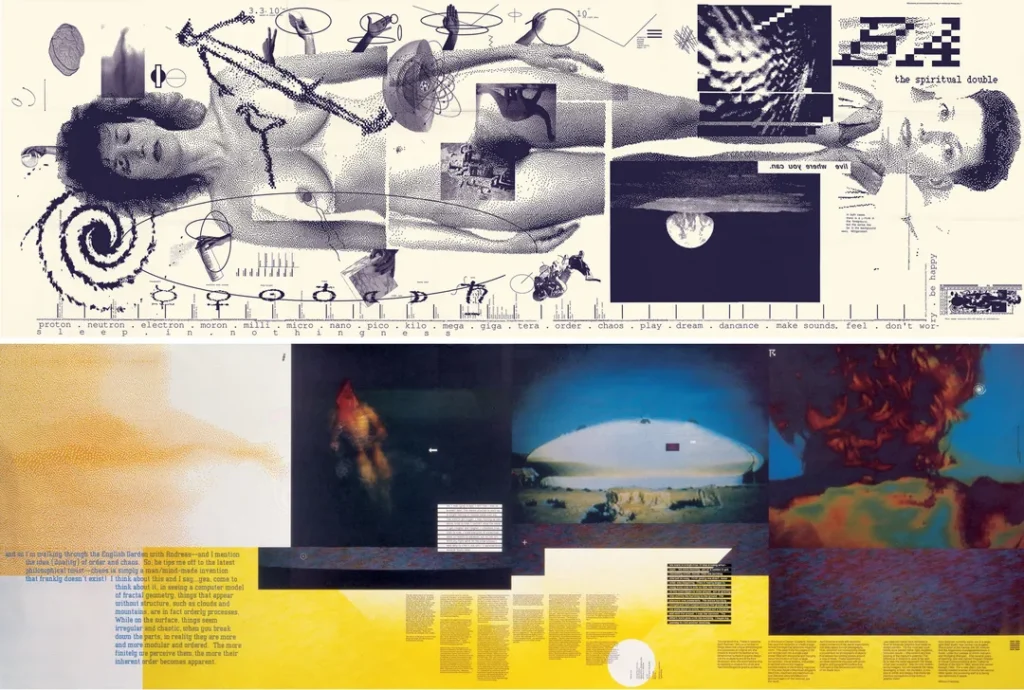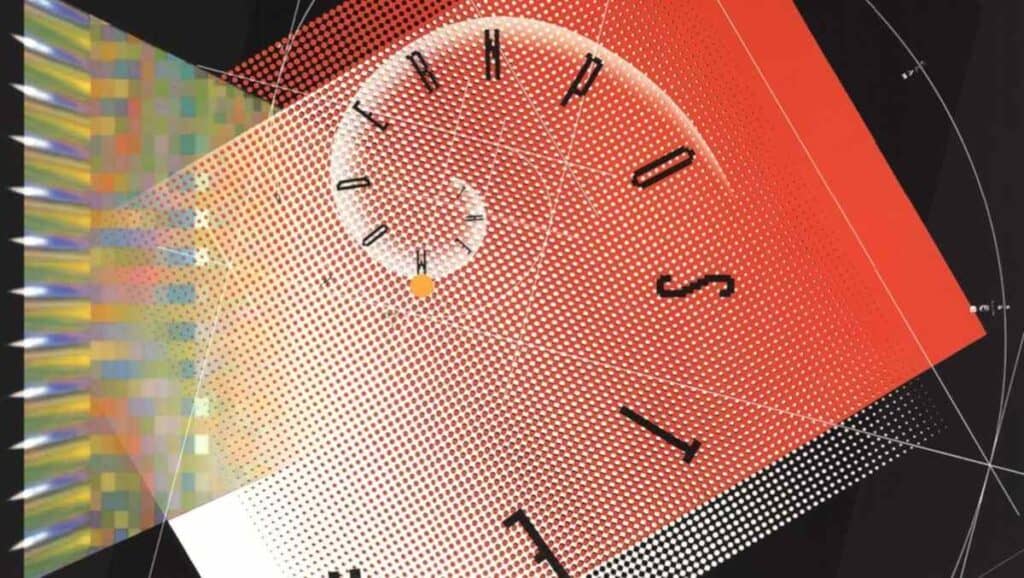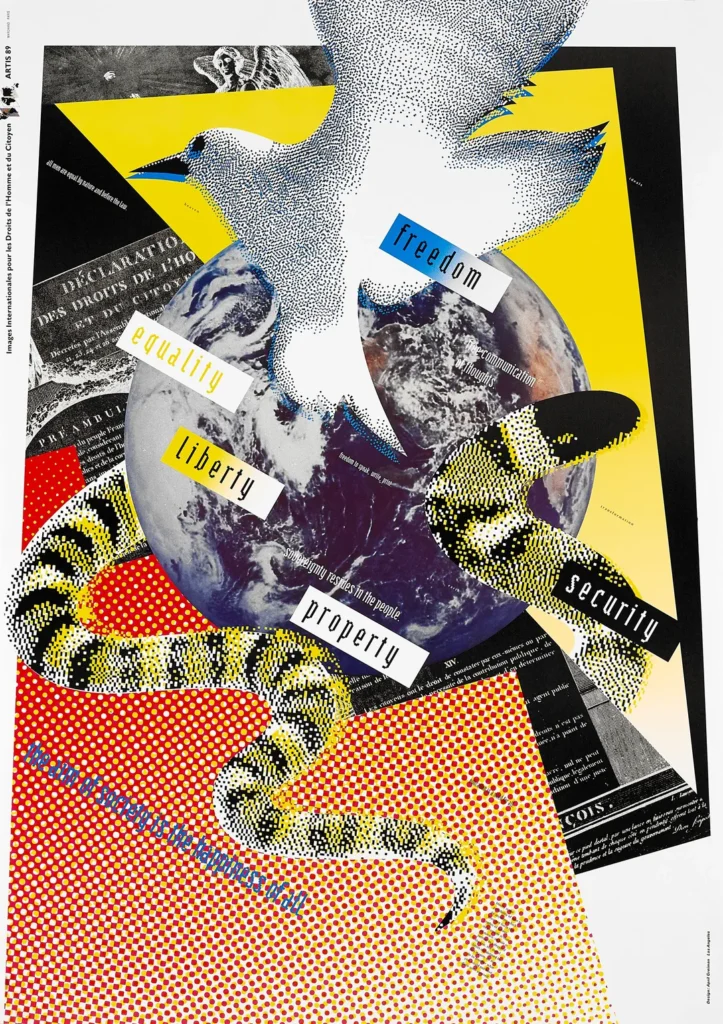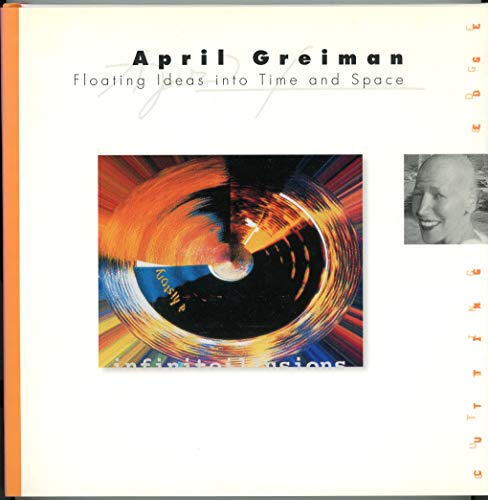April Greiman: A Pioneer in Graphic Design
Known for her pioneering work in graphic design and new media, April Greiman is one of the most influential designers of the late 20th century. Born in 1948, Greiman began her design career in the 1970s as part of the early wave of postmodern, deconstructivist designers who sought to break with the tenets of modernism. After studying design under the legendary Swiss modernist Wolfgang Weingart, Greiman brought an experimental Swiss punk aesthetic back with her to Los Angeles. There, she established her visual language that was vibrant, layered, and intentionally chaotic.
Greiman became known for her innovative typography, photography, and layout approaches. She utilised computer technology early on to create dynamic hybrids of images and text. Her posters and albums broke typographic and compositional rules, overlapping fields of colour and fragments of visuals in dynamic and expressive ways. In the 1980s and 90s, Greiman seamlessly transitioned into the digital realm, utilising nascent technologies to produce interactive projects on diskette and CD-ROM. She has been widely lauded for her ability to intuitively adopt new techniques and push the boundaries of each medium she works in.
Over her long and varied career, Greiman has made lasting contributions across fine art, graphic design, and new media platforms. She has been featured in numerous exhibitions and publications, recognising her status as an innovator and visionary. Greiman's constant challenging of formal design conventions and her early embrace of digital technology have paved the way for generations of designers who have followed in her footsteps.
Table of Contents
Early Life and Influences

The cultural backdrop of the 1960s, a decade characterised by artistic experimentation and societal upheaval, framed April Greiman's coming of age as a designer. Born in New York City in 1948, Greiman grew up immersed in the city's vibrant avant-garde art scene. The radical creative spirit of the '60s permeated her youth and early career.
Greiman's time as an art student in New York during the psychedelic 60s counterculture exposed her to groundbreaking movements like Fluxus, performance art, and conceptualism. The Fluxus artists' interdisciplinary experimentalism and disregard for tradition resonated. She also found inspiration in the typographic explorations of postmodern designers like Wolfgang Weingart emerging from Europe.
Moving to Los Angeles in the 1970s, Greiman continued to soak up the progressive West Coast arts culture. Her early commercial design work fused California New Wave punk aesthetic with Swiss modernist principles she had studied under Armin Hofmann. Greiman's style constantly pushed boundaries, violating modernist rules of order and decoration with expressive typography and radical visual juxtapositions.
The innovative spirit of the 60s radical art movements gave Greiman a creative foundation to build. The flux between order and chaos, restraint and exuberance, precision and expression in her body of work owes much to this backdrop of cultural rebellion. The social upheaval and artistic risk-taking Greiman witnessed in her youth empowered her path of perpetual experimentation and boundary-pushing over her long career. The era left an indelible mark on Greiman's avant-garde design ethos.
- Used Book in Good Condition
- Hardcover Book
- Greiman, April (Author)
- English (Publication Language)
- 160 Pages – 05/01/1990 (Publication Date) – Watson-Guptill (Publisher)
Education and Formative Years
The trajectory of April Greiman's groundbreaking career first took flight with her pivotal decision to pursue her love for design by enrolling in the Kansas City Art Institute in 1965. This critical move laid the educational foundation for Greiman's future innovations in graphic design.
At Kansas City, Greiman embraced philosophies about design's power as a tool for visual communication and cultural connection that would guide her trailblazing work. She viewed design as a bridge synthesising art, technology, and messaging. Following her studies, Greiman worked as a painter, photographer and illustrator, gathering further skills to incorporate into her design practice.
Eager to expand her knowledge, Greiman soon headed to Basel, Switzerland, to study under legendary modernist graphic designer Armin Hofmann at the Allgemeine Kunstgewerbeschule. This intensive immersion in the principles of Swiss design gave Greiman mastery of typography, composition, and grid systems.
However, she fused these techniques with her avant-garde sensibility, never allowing rules to limit her radical creative instincts. The Swiss design ethos of clarity and order met her tendency toward expressive deconstruction and experimental compositions. This interplay came to define her work.
These early experiences ignited April Greiman's commitment to continuously pushing boundaries and exploring uncharted creative territory in graphic design. The philosophy first sparked at Kansas City – that design is communication, connection and imagination without limits – drove her ongoing influence as she fluidly innovated across decades, mediums and technologies to redefine the field.
Merging Art and Technology

April Greiman's trailblazing career reached a pivotal juncture in the 1980s as emerging digital technologies captured her indomitable spirit and unwavering creative curiosity. Ever eager to experiment on the vanguard, Greiman leapt into the new frontier of computer-generated graphic design, becoming one of the first designers to integrate this revolutionary technology into her avant-garde aesthetic.
Greiman quickly recognised the monumental potential of nascent design software and multimedia tools in the 1980s. Her mastery of early Apple Macintosh programs enabled her to translate her signature style of typographic deconstruction and visual layering into bold new digital creations.
In groundbreaking projects like the interactive “Modern Poster” and video effects for the band Jay Hey, Greiman forged a visual language marrying pixelation, fragmentation, and her controlled chaos aesthetic. She utilised computer capabilities for collage, motion, and viewer interaction to produce digitally-native designs that felt exhilarating and limitless.
At a time when many designers were sceptical of computers, Greiman's embrace of emerging digital media disrupted conventional notions about graphic design practice. She demonstrated revolutionary new layout, composition, and communication design possibilities by seamlessly synergising her postmodern experimental vision with computer technology.
With her analogue and pioneering digital work, April Greiman consistently charted the unknown. Her intrepid forays into unmapped creative territory expanded the boundaries of design in her era and beyond. The field continues advancing along the inspiring digital trails Greiman first blazed.
Breaking Ground with “The Modern Poster”

One of Greiman's most groundbreaking and iconic projects during her pioneering days in digital design was 1986's “The Modern Poster.” This interactive piece was created entirely on nascent Macintosh technology and was published on diskette. It seamlessly blended typography, photography, video, and audio in a nonlinear, participatory experience.
“The Modern Poster” allowed users to actively engage with the content by clicking elements that would open up more layers of visuals and information. Its responsive nature was a completely new concept at the time. Greiman skillfully utilised pixelated images, fragmented typography, and her signature chaotic layouts to create a creative and limitless digital environment.
The project established Greiman as one of the first designers to fully grasp the potential of computers for graphic design purposes. She demonstrated how desktop publishing and multimedia tools could expand creative expression and redefine what it meant to be a poster or publication. Her innovative digital vision and execution garnered “The Modern Poster” critical acclaim and cemented Greiman's reputation as a pioneer.
The seminal work's significance was solidified when the Museum of Modern Art acquired it for its permanent collection – a rare achievement for an early digital design piece. The museum's recognition of its groundbreaking qualities has ensured “The Modern Poster” remains a landmark and milestone in the history of graphic design. For any designer working in the digital realm, this brilliant fusion of image, type and interaction set a new standard and opened up possibilities that continue to be explored today.
April Greiman's Design Philosophy

At the heart of April Greiman's pioneering design work lay a distinctive philosophy rooted in the symbiotic relationship between form and function. Greiman firmly believed that design should be visually arresting and clearly and effectively communicate a message.
This commitment to meaningful communication and clarity of information underpinned all of Greiman's designs, from her posters to her digital work. While her aesthetic was decidedly radical, rule-breaking, and avant-garde, she maintained that creative risks should always serve the content and enhance understanding.
Greiman pushed typography and composition into new territories, but this boundary-pushing was for more impactful visual communication. She broke the grid but introduced new systems of ordered chaos. She fragmented words and letters but in ways where the content remained comprehensible.
For Greiman, dynamic visual expression was inextricably tied to conveying information and emotion. Even her most expressive arrangements adhered to principles of visual hierarchy, drawing the eye where needed and getting the message across. She believed graphic design had a responsibility not just to attract attention but to communicate and educate effectively.
This philosophy of marrying form, function and meaningful messaging defined Greiman's career and set her apart. She repeatedly demonstrated how design could be aesthetically arresting, clear, boundary-breaking, and purposeful. Intertwined with her avant-garde vision, this drive for clarity and communication fueled April Greiman's lasting impact.
The Influence of Swiss Design

April Greiman's time studying under the legendary Swiss modernist designer Armin Hofmann at the Allgemeine Gewerbeschule Basel left an indelible mark on her design sensibilities. Greiman soaked up Hofmann's typography, composition, and colour theory teachings, embracing the Swiss design principles of simplicity, precision, and readability. At the same time, she brought her avant-garde artistic spirit to her work. This fusion resulted in designs that were both visually striking and highly functional.
Under Hofmann, Greiman mastered using the grid system and clear hierarchy in layouts. She learned how to create visual harmony and order through balanced proportions. However, Greiman also revelled in bucking conventions. She utilised typography in expressive, experimental ways – exaggerating and breaking letterforms to evoke meaning. Her compositions violated rules of alignment and proximity in bold, punk rock manoeuvres.
Greiman's time in Switzerland gave her the foundation for principled design systems. But her daring, rule-breaking ethos paved the way for her groundbreaking postmodern designs. The interplay between Swiss precision and avant-garde art in Greiman's work remained a signature throughout her career. She continued to produce designs that married order, functionality and visual harmony with expressive typography, collage-like layouts, and experimental compositions.
Impact on Graphic Design Education
In addition to her revolutionary design work, April Greiman has left an enduring impact through her extensive work as an educator and mentor. She has played a pivotal role in shaping new generations of graphic designers by passing on her technical skills and boundary-pushing spirit.
Greiman began teaching in the 1970s at her alma mater, the Kansas City Art Institute. In the 1980s, she joined the faculty of the groundbreaking Southern California Institute of Architecture (SCI-Arc), followed by a long tenure at CalArts. Greiman shared her immense knowledge of typography, photography, and emerging digital design techniques at these influential schools.
However, her most significant contribution as an educator was encouraging students to break free of conventions. She pushed them to embrace an avant-garde sensibility, take creative risks, and recognise that even the newest technologies could be tools for expression. Greiman inspired students through her infectious optimism about design's limitless possibilities if one remained open and curious.
The designers who learned from Greiman speak of how she shaped their outlook and enabled them to see design's potential without limits. By modelling how to merge experimentation with purpose, she equipped them to become innovators. With the creative boundaries she broke open as a designer, Greiman continued to push as a teacher.
Through her legacy as an educator who trained and influenced tomorrow's generation of designers, April Greiman's spirit of boundary-less innovation will continue impacting graphic design. The field will keep making leaps forward thanks to her far-reaching contributions as a teacher who passed on the imperative of embracing risk and possibility.
The Enduring Legacy

As we reflect on the remarkable creative journey of April Greiman, it becomes abundantly clear that her impact on graphic design is immense and immeasurable. Over decades of innovation, Greiman has proven herself a visionary pioneer whose boundary-pushing ethos and technical daring have left an indelible mark on the industry.
Greiman's fearless embrace of emerging technologies expanded design possibilities in uncharted directions. Her early adoption of desktop publishing, multimedia, and digital tools laid essential groundwork for today's design capabilities. She seamlessly transitioned from physical to virtual mediums, proving that an avant-garde spirit could thrive digitally.
Equally important was Greiman's relentless challenging of conventional design wisdom. From her postmodern deconstructed layouts to her eschewing of modernist principles, she empowered future generations to dismantle existing rules and follow their creative instincts. This willingness to take risks and subvert tradition has become a core ethos in contemporary design.
Ultimately, Greiman's holistic integration of form, function and technology proved that design can simultaneously be aesthetically arresting, communicating effectively, and pushing progress forward. Her principled yet boundary-less approach created a new visual language that changed design forever.
Decade after decade, April Greiman produced visionary and enduring work. Her expansive legacy continues to shape graphic design today, whether through the direct influence of her iconic projects or the creative doors she broke open. Greiman's unbound creativity, technical agility and design convictions pioneered new frontiers – leaving an impact that will continue to inspire imagination long into the future.
- Used Book in Good Condition
- Hardcover Book
- Greiman, April (Author)
- English (Publication Language)
- 64 Pages – 05/06/1998 (Publication Date) – Watson-Guptill Pubns (Publisher)
Conclusion
In a world where design constantly adapts to new technologies and trends, April Greiman's legacy remains a guiding light for designers worldwide. Her fearless pursuit of innovation, commitment to meaningful communication, and visionary approach to merging art and technology have left an indelible mark on the graphic design landscape. As we celebrate her life and work, we are reminded that true design greatness knows no boundaries and is limited only by the scope of one's imagination.
FAQs
What are some of April Greiman's most famous works?
April Greiman's “The Modern Poster” is undoubtedly one of her most famous works. It revolutionised digital design and was exhibited at the Museum of Modern Art in New York.
How did April Greiman merge art and technology in her work?
Greiman was among the first designers to experiment with digital design tools in the 1980s. She used early computer software to create groundbreaking designs that blended typography, imagery, and interactivity.
What was April Greiman's design philosophy?
Greiman believed in the importance of clarity and meaningful communication in design. She fused Swiss design principles with her avant-garde style to create visually striking and functional designs.
Where did April Greiman teach and mentor aspiring graphic designers?
Greiman taught at the Southern California Institute of Architecture (SCI-Arc) and the California Institute of the Arts (CalArts), inspiring numerous students to explore innovative design approaches.
How has April Greiman's legacy influenced modern graphic design?
Greiman's willingness to challenge conventions and embrace technology has had a profound and lasting impact on the field, shaping modern graphic design and encouraging designers to think beyond traditional boundaries.
Last update on 2024-05-05 / Affiliate links / Images from Amazon Product Advertising API


